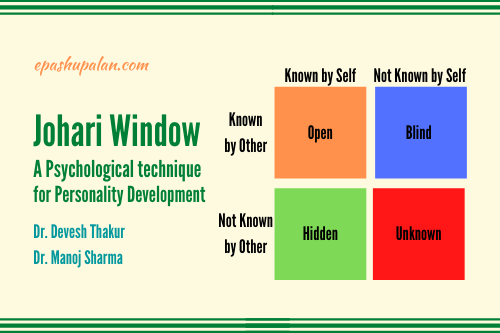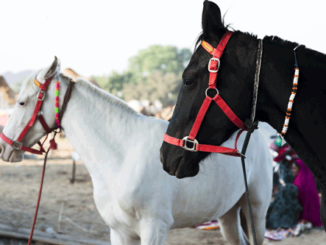Personal development is a lifelong process and it enhances confidence and self-worth. Self-knowledge is the first step in personal development. It is crucial that you understand yourself; in order to be aware of your own capabilities and the inner resources that you have available to deal in a positive and confident way with a busy work environment, your colleagues and the clients. Uncovering hidden aspects of your character and highlighting your limitations may hold the key to better relationships and realisation of untapped potential. The process of knowing one’s own principle, beliefs, feelings, personality, strengths, weaknesses, preconceptions, attitudes and responses in different situations is called self-awareness. Johari window is a psychological tool used to develop self-awareness and promote better relationships among people. It was created by two American Psychologists Joseph Luft and Harry Ingham in 1955. The word “JOHARI” comes from the first names of its developers Joseph and Harry (Joharry).
Johari Window of Model
Johari window technique developed by luft(1969) helps people to become more self-aware and understand their relationship with self and other people. Main idea of the model is that people often have self-images that are visible or hidden, yet often perceived differently by others.
Four Dimensions of Johari Window
Johari window consists of four dimensions organized into a 2×2 matrix as shown below:
- Known to You Unknown to You
- Known to others Open Self Blind Self
- Unknown to others Hidden Self Unknown Self

(i) Open self
This part is our open window, the part of us we display to colleagues and clients. It deals with personality that is known by both self and others. It is also referred to as the public area. It includes anything you know about you that you are willing to share. Individuals can build trust between themselves by disclosing information to others and learning about others from the information they in turn disclose about themselves. This area drives clarity and builds trust. All contact in this environment happens through a two-way mechanism. Consequently, the individual socialises with others about themselves and receives continuous input from the other group members. As a result, the group becomes more efficient and the relationship is very dynamic. The process of soliciting feedback is very common in this group. This takes place within a group that has an understanding, and the other person’s feedback is heard. The more open area means the person is more open and has good transparent communication.
(ii) Blind Self
This region deals with knowledge unknown to self but visible to others, such as shortcomings or annoying habits. If someone ignores this part, she will have more blind area. The Blind area, or blind spot, is the area where others know certain information about your personality. However, this is information that you are not aware of. Feedback from others can make you more aware of your negative traits. Moreover, it can also draw attention to the positive ones you are not appreciating.
Other people may interpret your personality differently from how you may expect. Consequently, for efficient communication, you should try to reduce this area. The blind Spot can be very hard to manage, and it can lead others to talk about you. This is because they see something you don’t.
With the help of feedback from others you can become aware of some of your positive and negative traits as perceived by others and overcome some of the personal issues that may be inhibiting your personal or group dynamics within the team. It is also possible to increase your open area by asking for feedback from people. When feedback is given honestly to you it can reduce the size of your blind area. Maybe you interrupt people before they have finished making their point which can cause frustration. Alternatively, people may always want to talk to you because you are a good listener. Sometimes you don’t realise these aspects of your character until it is pointed out. By working with others it is possible for you to discover aspects that neither of you may never have appreciated before
(iii) Hidden Self
This is the information about you that you know but others don’t know. The Hidden Area, or façade or private self is the information that you conceal from others. You know the information in this space, but others are unaware of it. The reason for this could be that the information is of a personal nature. Consequently, you might be reluctant to share. This includes, for example, secrets, past experiences, and feelings. To some extent, we naturally wish to keep work and personal life separate. However, if we are too much of a ‘closed book’ we risk appearing unfriendly or disapproving. At the opposite end of the scale, too much inappropriate disclosure may unsettle working relationships.
There is a need, not only for self-awareness in this issue, but also to maintain a balance.
(iv) Unknown Self
The characteristics of the person that are unknown to both self and others. The information in the unknown area is unknown to you as well as to others. For example, undiscovered potential, unconscious needs and motivations. There is no contact over this unknown area purely because both sides are unaware of this, so it will not become the subject of discussion. Collective efforts of self and others are effective in reducing this area.
Based on the attitudes and behavior of people, their studies identified four types of interpersonal styles. Each interpersonal style has special characteristics and generates the related consequences as discussed below.
Interpersonal style
1: Unknown self: Unknown self is the situation of the things that I do not know and the others also do not know. The characteristics, analysis and the consequences of this situation is presented below.
Characteristics
Personal potential is not exploited
Creativity is suppressed
The persons hardly ask for feedback or exercise self-exposure
They present rigid behavior, hardly take risks
They are usually quiet, reserved, and avoid group participation
Analysis
- This behaviour seems to be related to: (I) interpersonal anxiety and (ii) lack of self-confidence
- These people prefer to withdraw rather to self-expose and ‘grow’
Consequences
These people usually:
- Attract hostility
- Develop loneliness
- Show dissatisfaction
- Live isolated
- Avoid friendship
Interpersonal style 2: Concealed self: Situation: I know, but others do not know.
Characteristics
- These people hardly self-expose
- They hardly express their ideas, judgments, and actions
- They ask feedback from others about their performance and behaviour
- Consequently, they reduce ‘blind self’
- They do not share experience and prevent people from learning from them
Analysis
Persons who maintain this kind of behaviour
- Seem to be afraid of being rejected or receive aggressiveness from others
- Are afraid of not receiving support if others get to know their thoughts and feelings of ambition
- Show lack of self-confidence and believe that they are able to manipulate and control others(power) through the process of omitting information
Consequences
These persons usually:
- Generate tension and negative feeling among peers
- Develop rejection and antipathy among others, including avoidance
- Are considered selfish and useless in terms of group development
Interpersonal style 3: Blind self: Situation: I do not know but the others know.
Characteristics
- These people often use the process of self-exposure
- They hardly ask for feedback
- They participate actively in groups and give information
- They give feedback to others easily. They tell others what they think and feel towards them
- They are very critical
- They have a high idea of themselves. They like to boast and put people down. ‘They are the best in life’
Analysis
This kind of people hurt others easily as they assume the behaviour of being frank, honest and constructive towards others
- In general, others perceive these individuals as very self-cantered
- They are insensitive to feedback.
- They do not care about the way people perceive and see them
- Unconsciously, they are afraid of knowing their self-image
Consequences
These persons usually:
- Generate negative feelings among peers
- Cause peers to feel disrespected by them
- Cause peers to often develop lack of confidence, hostility, and to become very defensive when dealing with them
Interpersonal style 4: Open self: Situation: I know and others also know.
Characteristics
- These people maintain an IDEAL behavior to facilitate an interpersonal relationship
- They frequently exercise both processes: ask for feedback and self-expose
- They permit frankness, sincerity etc.
- They use emphatic communication very often
- They have open communication in groups and discuss any issue thoroughly to avoid misunderstanding
Analysis
In general, such people are self-confident. They are ready to take risks and evaluate results
- They promote chances for innovation, implementation of new ideas
- They are not afraid of losing face because they believe that they are in a constant process of learning
- They help to promote and develop effective and modern organizations
Consequences
These people usually:
- Generate high expectation of productivity, supportiveness among the peers
- Can also generate defensive behaviour of others who are not used to dealing with authentic
behaviour - Contributes to changing practices and interpersonal relationships in an environment by
implementing openness, genuineness etc. However, this is a very slow process
The knowledge of these styles and consequences will assist a great deal in establishing successful partnerships
Johari Window and Personality Modification
A person who wants to develop personality must focus on expanding open area and reduce other three areas by different methods. People are advised to reduce the area of blind spot and unknown while expand the arena. The lesser the hidden personality is, the better the person becomes in relating with other people. The shape of all four areas of Johri Windows is not always equal and can be modified by feedback and disclosure. The more feedback I encourage as a leader, the more my public area will expand and reduce my blind area. However, to encourage feedback, I must be able to accept criticism and this can be a major roadblock to some leaders. The smaller my blind area the more I learn about myself and the better person I can be. A second process that will alter the shape of the Johari Window is disclosure. The more I disclose about myself through my behaviour, the more you can gain insight about me, and the same for you. This cannot be done by phone or letter as well as it can be accomplished by a one-on-one sitting. Disclosure is good as long as it is relevant to the organizational goals and setting. Telling your peers about your personal life may not be appropriate for an organizational setting, but maybe very appropriate to discuss at home. The more I disclose about myself the larger my public area and the smaller my private area thus, you get to know me better and we can work more closely together
Interpersonal Relationships
The Johari Window maybe applied to interpersonal relationships and the areas are dynamic with a change in one area that will affect another. Since we interact with one another there are certain behaviours that have an immediate effect on one another. For example, a threat tends to decrease openness and trust tends to expand our public area. The smaller that my public area is the less communication. Interaction builds trust and hence increases the public area, thus decreasing the other areas.
If the area which is blind, hidden and unknown remains bigger the person can be considered be low in self-awareness.
Johari Window at workplace
The goal of institutions should be to create more open area for each member of organization or a team. Open, honest & transparent communication need to be encouraged by leaders or older members of team. By soliciting feedback and being open to feedback increases our awareness of how others perceive us and we shrink our blind spot. The level of trust put by organizations and teams helps a person to reduce the hidden self. The model can furthermore be used to improve the relationship of one group with another group, group development and group dynamics. Because of this, the model is often used to support team development. At workplace the Johari window can help people to better understand their communication with others.
Limitations of Johri Window
- Some things are perhaps better not communicated with others.
- People may pass on the information they received further than you desire or use it in a negative way.
- Some people or cultures have a very open and accepting approach to feedback and some do not. People can take personal feedback offensively so it’s important when facilitating to exercise caution and start gradually.
References
- Anandajayasekeram P and Puskur R(2010). Key skills for effective partnership management: Interpersonal relations, feedback and communication. IN: Strengthening partnerships and networks in agricultural research for development. ILRI (International Livestock Research Institute), Nairobi, Kenya
- Anonymous (2013) Understanding the Johari Window model available as https://www.selfawareness.org.uk/news/understanding-the-johari-window-model
- Gadd, G. (2012). Career enhancement through personal development. Veterinary Nursing Journal, 27(6), 235-236.
- Thomas, F. B. (1992). How to interpret yourself/Johari Window. In Proceedings of the 20th annual ACM SIGUCCS conference on User services (pp. 225-230).







Be the first to comment